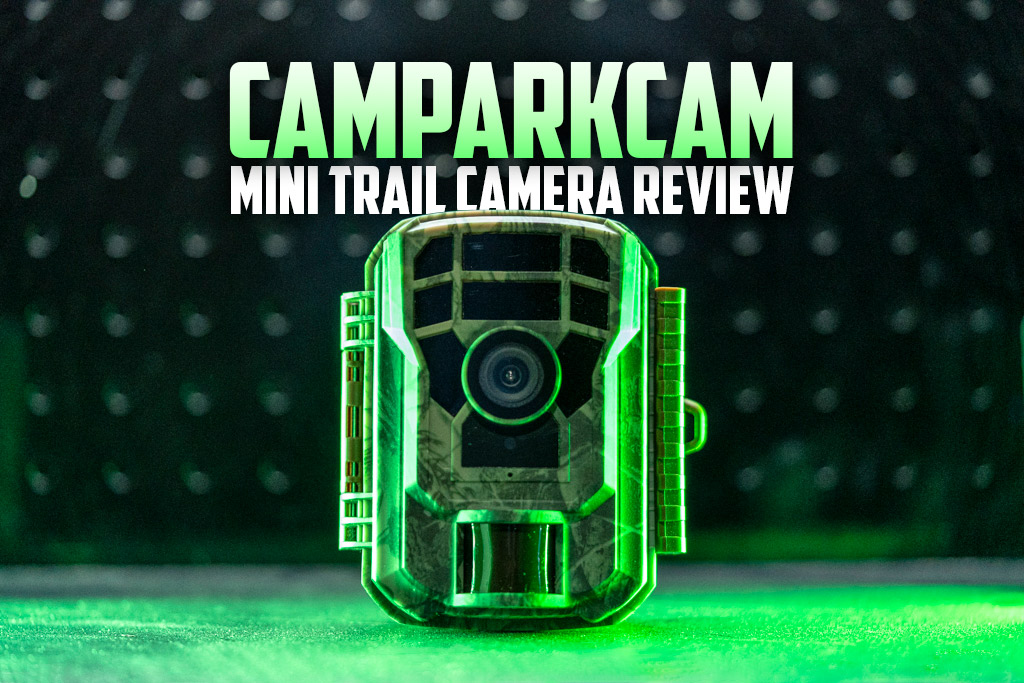
CAMPARK Trail Camera – Mini Review
Disclaimer: This page contains affiliate links, meaning we receive commissions for any purchases made through the links on this page.
Are you hunting for a trail camera? Have a look at our review of the CAMPARK mini trail camera. We’ll cover this packable trail camera’s specs, pros, and cons. By the end of this guide, you’ll know whether it’s worth buying a set of these nifty scouting cameras.
The CAMPARK mini trail cam has a lot going for it. For one thing, it’s small – smaller than you might expect. This camera can fit in the palm of your hand, and that small size has a lot of advantages. Not only are these cams easy to conceal, but it’s also easy to carry around a whole pack of them.
A good trail camera will let you live with the bears for a bit (or at least spy on them). Let’s chat about why you might choose the CAMPARK 2-pack mini trail camera for your next reconnaissance mission.
Why Do People Like The CAMPARK Mini Trail Camera?

Why is the CAMPARK 2-pack trail camera popular? Three main reasons: price, perception, and portability.
Let’s break that down.
Price of the CAMPARK: The price is right. You get two cameras for about ninety bucks — that’s only $45 per camera. For the quality and features of these cameras, that’s not too shabby.
Perception (Image Quality/Sensitivity) of the CAMPARK: Again, for the money, you get average image quality, with 1080P videos, night vision, 60 ft trigger distance, and easy playback.
Portability of these trail cams: These cameras are easy to lug around. If you’re trying to scout out a large piece of property, you can easily buy a few sets of these, toss them in the backpack, and set them up wherever your heart takes you.
It’s this triad of strengths that makes this wildlife camera so compelling. But let’s get into the details, and then we’ll discuss the pros and cons.
Key Features Of The CAMPARK Mini

Before we walk further down the trail, let’s look at some specs for the CAMPARK Mini Cam. We’ll discuss the trail cams’ size, weather rating, lens angle, and more.
Specs of the CAMPARK Mini trail cam:
- Min Cam Size: 70mm wide (2.6 inches), 105mm (4.1 inches) tall, 40mm deep (1.6 inches) – besides the thickness, this is about the size of an average smartphone – pretty small!
- Photo quality (megapixels): 24MP still images and allows for 1080P video (AVI format).
- Lens Angle: 120 degrees (this is pretty wide, giving you a lot of image capture)
- Detection distance: Listed at 65 feet (20 meters)
- Night vision capable: Yes, for both pictures and video.
- Waterproof level: IP56 (this will withstand most weather!)
- Temperature rating: As high as 140 degrees Fahrenheit and as low as -4 F.
- Batteries required: 4 AA batteries (not included)
- SD card port: accepts regular-sized SD cards and has a USB port (no SD card included).
- Digital display: Has an LCD built-in for rapidly viewing footage.
- Colors: Two color options – a green camouflage option and a black.
- Price: ~$89.00 (and you get two cameras).
Now that you know the specs, let’s look at what you get in the box when you buy this trail cam.
What’s In The Box?

Here’s a quick overview of what you get when you order the CAMPARK mini trail camera.
The box’s contents should be consistent from purchase to purchase, but double-check the model when you order.
What you get when you buy the CAMPARK mini trail cam:
- Two Cameras (it’s called a 2-pack for a reason!)
- Comes with straps for trees (for quick and easy installation)
- Metal Mounts (if you want a more permanent/stable mount)
- USE Cables (for directly transferring photos)
- User manual
Remember that the camera does not come with batteries or an SD card; however, this is typical, and you’ll probably want to invest in a good SD card/battery anyway.
Pros To The CAMPARK Mini
We talked a little about the core benefits of this trail cam in the first section. Now, let’s expand on that and go into some more specific reasons people like this scouting camera.
Pros of the CAMPARK trail camera:
- Smaller is easier to hide: If you’re trying to hide trail cameras on your property, you’ll find that the smaller size makes it more convenient. Check the legality of trail cameras on public land in your area, but some areas may allow them.
- Having two is nice: This set gives you two. If you’re just getting started, having two cameras helps you capture the most footage – and keeps you going if one goes down.
- May use less battery life: These smaller cameras only take four batteries (drain less power than full-sized cams) instead of the typical eight. This can lead to less cash spent on batteries, especially if you go for high-quality batteries.
- Wide viewing angle: For such a small camera, you get a wide viewing angle (120 degrees). Many larger cams are only 90 degrees. This ensures that you catch as much as possible.
- Quicker video triggers: With these cameras, you get a faster trigger for the video – it can be set to take video about 3 seconds after it senses movement, which is faster than many other models.
Of course, nothing is without a few downsides. Let’s talk about the things you should be aware of before you buy this trail camera.
Cons To The CAMPARK Mini
Let’s go over a few downsides to the camera. In many cases, these downsides can be remedied with thoughtful preparation.
Cons to the CAMPARK hunting camera:
- No batteries or SD card included: We already mentioned this, but it’s worth keeping in mind. This isn’t so much a con as it is something to be aware of (many trail cams don’t come with batteries/SD).
- No Bluetooth or Wifi: The mini model does not have the ability to connect to Bluetooth or wifi via an app.
- Can struggle with night mode: Night mode will never be as clear as the daytime. Just ensure that you set up the trail camera correctly and understand it won’t have the same image capture capabilities as it will during the day.
- Average image quality: The image quality is on par with other trail cameras, don’t expect high-resolution miracles from the camera’s small sensor.
- Protruding lens: Some users have noted that the lens on the camera protrudes to the point of catching rain or snow. Whether this is a problem will depend on where you set up the camera; however, if this happens to you, consider devising a little shelter to shield some of the weather.
- Cold weather: These cameras are rated for -4 degrees Fahrenheit. That’s cold, but in the colder regions of the US, negative four is pretty standard during the winter. You can remedy this by using quality batteries (and doing most of your scouting in the late summer/fall).
And that’s about it. Now let’s wrap things up and chat about our conclusion.
Should You Buy the CAMPARK Mini Trail Camera?

If you’re in the market for some trail cams and you’d like an affordable place to start, the CAMPARK 2-pack mini trail camera is a good starter option. You get a lot of features in this outdoor camera, and at the price point, you won’t be heartbroken if one of them gets a little banged up during your adventures. The only downside most users will miss is not having Bluetooth or wifi features. The larger CAMPARK cameras include these features, along with a handy app.
This trail cam would work especially well for those who want a concealable, more portable option. And, if you use some good AAs, you might even find that you’re spending less on batteries. All-in-all these mini trail cams get a recommended rating.
My overall rating of the CAMPARK Mini Trail Camera: 4/5 

